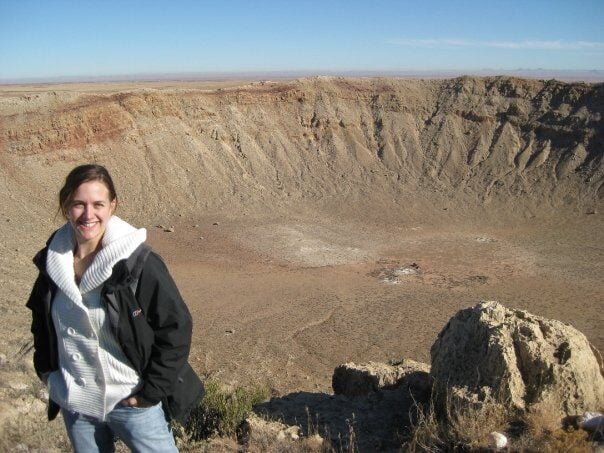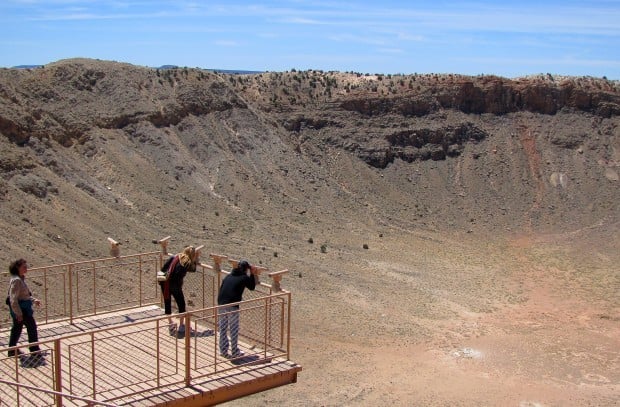The asteroid that killed the dinosaurs may have had an accomplice.
A team of researchers, including one from the University of Arizona, have found evidence of a second large impact crater at the bottom of the Atlantic Ocean that appears to be from the same time period, roughly 66 million years ago.
University of Arizona research scientist Veronica Bray said the newly discovered crater could have been made by the “little sister asteroid to Chicxulub,” the 6-mile-wide space rock that wiped out 75% of the Earth’s plant and animal species, including all nonavian dinosaurs.
Uisdean Nicholson, a geologist at Heriot-Watt University in Edinburgh, Scotland, found the crater by accident in 2020, during unrelated seismic exploration of the Atlantic seabed about 250 miles off the coast of Guinea in West Africa.
The crater is more than 5 miles wide and buried roughly 950 feet below the seabed.
“I’ve interpreted lots of seismic data in my time but had never seen anything like this,” Nicholson said in a written statement. “It has particular features that point to an asteroid. It has a raised rim and a very prominent central uplift, which is consistent for large impact craters.”
He also found signs of a chaotic debris field extending away from the crater for more than 10 miles, suggesting material that was violently ejected by the impact and tossed around in the churning water.
A University of Arizona computer model simulates the asteroid impact that created a newly discovered deep sea crater. Video courtesy of Veronica Bray.
Nicholson named the feature Nadir crater after a nearby underwater mountain.
He brought in Bray, fellow impact expert Sean Gulick from the University of Texas at Austin and research scientist Benedict Aduomahor from Heriot-Watt University to help analyze the discovery. Their findings were published Wednesday in the journal Science Advances.
Based on her computer simulations, Bray said the crater is consistent with an asteroid about a quarter of a mile wide crashing down in water some 2,500 feet deep.
The impact would have caused widespread devastation in its corner of the globe, vaporizing everything in the immediate area, triggering a magnitude-7 earthquake and generating a series of tsunamis hundreds of feet high, she said.
“If you were standing on the west coast of Africa, you would have seen the sea go out and the sand stretch for miles” before the first giant wave hit, Bray said.
She estimates the energy released by the strike was about 1,000 times greater than the January 2022 eruption and tsunami in the South Pacific island chain of Tonga or about 300,000 times greater than the atomic blast that destroyed Hiroshima.
Nicholson has already applied for funding to drill into the seabed and confirm that what he found is an asteroid crater. Bray said that work is slated to happen in 2024 as part of another seismic investigation off the coast of Africa.
During the trip, researchers also hope to collect core samples containing rock melted by the asteroid impact, so they can use the material to determine the precise age of the crater, plus or minus about 11,000 years. “It’s the best style of dating that we have,” Bray said.
If the two impacts turn out to be separated by tens of thousands or even hundreds of thousands of years, it could point to a cluster of apocalyptic asteroid impacts that brought the Cretaceous period crashing to a halt.
But if the date of the Nadir sample matches up with the dinosaur-killing Chicxulub event, it would suggest that the smaller asteroid broke off from the larger one before they both slammed into the Earth roughly 3,400 miles apart.
Or, as Bray put it: “It’s a chip off the old block.”
“This would have helped finish off the dinosaurs,” she said, before laughing at her use of the word “helped.” “As an impact modeler, I think of what’s good for the crater,” Bray said.
Not that Chicxulub needed any help.
When that asteroid slammed into what is now the western Caribbean and the Yucatan Peninsula, it blasted a crater 110 miles wide and 12 miles deep, launching debris into space and shrouding the planet in hot dust, ash and rocks that set fire to most of the world’s forests as they rained down from the sky.
It also produced “megatsunamis” nearly a mile high and a seismic event of magnitude-10 or greater that “would have left the Earth ringing like a bell for days,” Bray said.

Meteor Crater near Winslow is one of fewer than 200 asteroid impact craters that have been identified across the globe. A University of Arizona researcher was involved in the recent discovery of a deep-sea crater that could date back to the extinction of the dinosaurs.
The discovery of the Nadir crater is significant whether it’s directly linked to Chicxulub or not, said Gulick, the impact expert from the University of Texas.
“Despite 4 billion years of impactors hitting Earth, only 200 have been discovered,” he said in a written statement. “It is thus exciting news whenever a new potential impact is discovered, especially in the hard-to-explore marine environment.”
To date, fewer than 20 marine impact craters have been confirmed across the globe.
Bray said the sediment cores due to be collected from the Nadir site in 2024 could also help shed light on how life recovered from the cataclysm and how long that might have taken.
Bray joined the U of A’s world famous Lunar and Planetary Laboratory 13 years ago, after earning her doctorate degree in the United Kingdom.
In addition to her work as an impact modeler, Bray logs time as a spacecraft operations engineer, assisting with the Cassini mission to Saturn, the New Horizons mission to Pluto and NASA’s HiRISE camera, which is operated from the U of A campus as it circles the red planet onboard Mars Reconnaissance Orbiter.
Work on the Nadir crater has been a nice change of pace.
“I’m usually out in the solar system,” Bray said. “It’s interesting to be doing terrestrial modeling.”
Collection: Read more on U of A research
A capsule of rubble from the construction of the solar system is now in the eager arms of scientists. It could offer clues about the origins of the solar system and life on Earth.
If everything goes according to plan, Sunday morning should start with the safe return of samples from the University of Arizona-led space mission to the asteroid Bennu.
The culinary team at the University of Arizona has created a full menu of space-themed recipes to cater your Sunday morning watch party for the return of the OSIRIS-REx asteroid mission.
For Star subscribers: As NASA's asteroid sampling mission is coming home, the University of Arizona professor in charge talks about the journey, the stakes and how he's feeling.
The Arizona economy is expected to post solid gains this year and next if the U.S. economy avoids a recession as expected, University of Arizona economists say.
The grant to the University of Arizona's Dr. Emmanual Katsanis will help his fight against childhood cancer.
You can walk the length of our vast solar system at a new, permanent exhibit stretching more than half a mile across the University of Arizona campus.
A new UA science and technology center funded by a National Science Foundation grant, New Frontiers of Sound Science, was announced Thursday.
For Star subscribers: When completed around the start of the next decade, the Giant Magellan Telescope will be the world’s most powerful land-based telescope, though others in development could rival it in size.
When OSIRIS-REx returns its asteroid samples to Earth Sept. 24, two University of Arizona researchers will be among the first to examine the precious material.
OSIRIS-REx will return with its priceless asteroid cargo on Sept. 24, and the University of Arizona's mission team is busy rehearing its central role in recovering the samples.
A University of Arizona prof found a surprising co-author — astrophysicist and legendary Queen guitarist Brian May — for the world's first comprehensive atlas of an asteroid.
A researcher from the Tucson-based Planetary Science Institute has received a prestigious, lifetime achievement award from NASA.
NASA unveils stunning closeup of a stellar nursery to mark the space telescope's first full year of scientific observations — including many by University of Arizona astronomers.
For Star subscribers: Saguaro National Park is home to one of the world's longest-running annual plant surveys, and Tom Orum and Nancy Ferguson know the research subjects better than anyone.
Chewed licorice-gum discarded at a Tucson drug store by American gangster John Dillinger is among many interesting finds at the University of Arizona's Museum of Pharmacy.
For Star subscribers: A salty discovery by scientists at the University of Arizona could bolster the idea that most, if not all, of the water on Earth was delivered here long ago inside of space rocks.
Experts are encouraging people in mourning and their loved ones to take symptoms seriously and prioritize self-care.
The University of Arizona and tire maker Bridgestone will lead a five-year, $70 million mission to turn the desert shrub guayule into a domestic source of natural rubber.
For Star subscribers: A research team with Tucson ties has used a new imaging technique to produce a full-resolution version of the first picture ever captured of a black hole.
The 89,000 square-foot-building is designed to promote interdisciplinary scientific research and collaboration.
For Star subscribers: University of Arizona researchers watched closely last week as a potentially dangerous asteroid whizzed past Earth. Here's what they learned.
Six UA College of Engineering students are constructing a 250-pound battle robot, capable of causing serious destruction, to compete in a TV show.
The University of Arizona and others were awarded almost $4.8 million in federal money to transform farming and growing practices in drought.





























